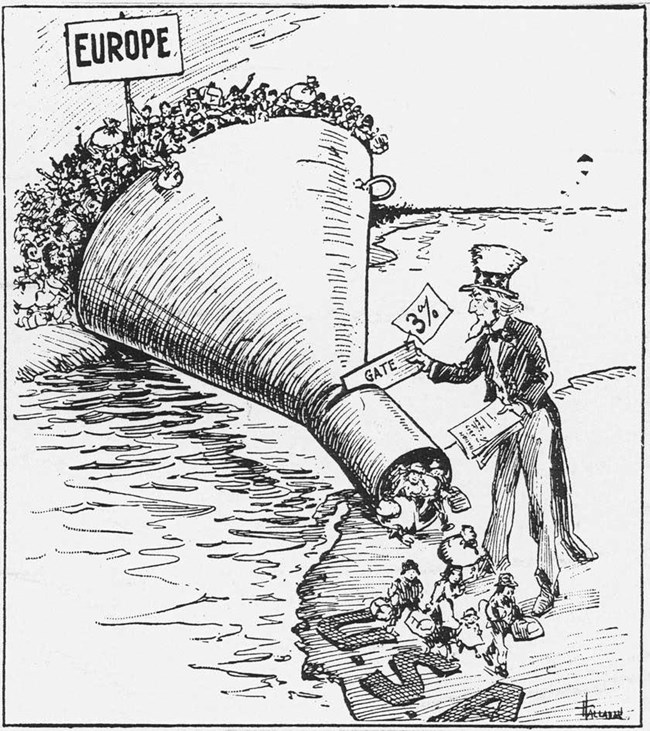Last updated: July 18, 2017
Article
Closing the Door on Immigration

Library of Congress
US participation in World War I fanned the flames of anti-immigrant sentiment, despite the fact that many immigrants served with distinction in the US military. This time, the hostility was directed toward the southern and eastern Europeans that made up the wave of immigration occurring at the same time as the conflict. The geopolitical tensions that drew the United States into the war, combined with hostile depictions of our foreign foes through political cartoons and other media depictions, increased the popularity of isolationist and nativist viewpoints.
Anti-immigrant movements existed in the United States long before this. Nativist groups such as the Know-Nothing Party were active at the time of the first great wave of immigration in the mid-1800s. The first inspections of immigrants started in 1855 in response to the arrival of large numbers of Irish fleeing their homeland’s potato famine. America’s first big restriction on immigration, the Chinese Exclusion Act of 1882, came in reaction to the arrival of Chinese immigrants in the mid-1800s. The 1907 “Gentlemen’s Agreement” with Japan and the Immigration Act of 1917 further curtailed Asian immigration.
Immigration to the United States began to rebound following the conclusion of World War I. Among those leading the resurgence were refugees from the Russian Revolution, the Armenian genocide, and the collapse of the Italian economy. In the United States, however, demobilization led to increased competition for jobs and growing unemployment. Economic concerns combined with ethnic prejudice to end America’s “open door” immigration policy in the 1920s.
The Emergency Quota Act of 1921 established the nation’s first numerical limits on the number of immigrants who could enter the United States. The Immigration Act of 1924, also known as the National Origins Act, made the quotas stricter and permanent. These country-by-country limits were specifically designed to keep out “undesirable” ethnic groups and maintain America’s character as nation of northern and western European stock. The final quota figures were based on the ratio of different ethnic groups existing in America in 1890, before the second big wave of immigration by southern and eastern Europeans.
To implement the quotas, the whole immigration process was changed in 1924 to the visa system we still use today. Ellis Island was reduced to being a detention center for a trickle of immigrants with problems upon arrival and for persons being deported. Parts of the island fell into disuse after 1924 or were used by other government agencies for other purposes. Eventually, the government decided it wasn’t worth keeping up the huge Ellis Island complex for that trickle of detainees, and the facility was abandoned in 1954.
When Adolf Hitler and the Nazis came to power in the 1930s, they showed the world the horrors that result if eugenics theories are carried to an extreme. It would take a Second World War in the 1940s to stop them, even as the US quota system prevented many refugees from escaping the Nazis. It was not until the Immigration Act of 1965 that America’s ethnicity-based quotas would disappear and the United States would adopt a more ethnically neutral way of controlling immigration.